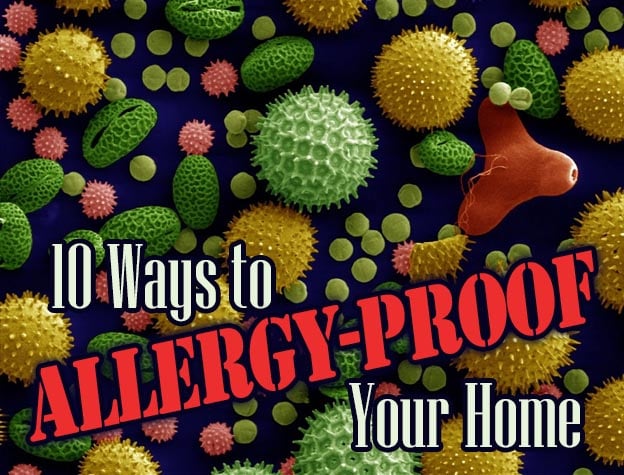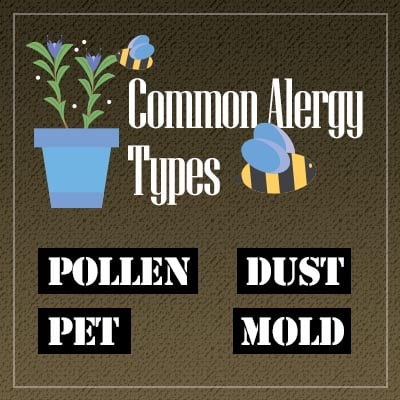
Allergies affect millions of Americans, and for these allergy sufferers dealing with the symptoms their allergies create can be a real nightmare. Medications can cause grogginess or keep you up at night, while nasal and sinus issues can make day-to-day life completely miserable. It’s hard to control natural factors that create a lot of allergies, such as the seasonal pollen that triggers many people’s allergies, but when it comes to your home, you have much more control. Rather than wait to deal with allergy symptoms, why not make your home as allergy-proof as possible and help reduce your allergic reactions from the very start? To help with this, we’ve compiled 10 great ways of turning your home into your own anti-allergy safe haven.
 Know Your Allergies:
Know Your Allergies:
Before we launch into our allergy-proofing methods, it’s important to point out that your success at ridding your home of allergens that trigger your symptoms is going to have a lot to do with your own understanding of your specific allergies. Some allergens need to be targeted in different ways, so knowing what triggers you and what doesn’t will help you focus more on the real problems. Common allergies include pollen allergies, dust allergies, pet allergies, and mold allergies. In order to figure out which of these is affecting you, you need to meet with an allergist in order to discuss your symptoms and the factors you’re typically exposed to. An allergist will also be able to administer a skin prick test that will point to the specific allergens that trigger your reactions.

Air Filtration
While your only real bet for experiencing filtered air outside would be to wear a respirator mask, you can experience clean, filtered air within your own home. While you are in an enclosed environment when inside, air from outside still finds its way in, and along with it comes all of the pollen you’re trying to avoid. Allergens will also settle on you and your clothing and even your pets after being outside, so once you come in again, these allergens inevitably are released into your living space. Your home’s central air filters can be replaced with high-grade MERV II air filters that will trap allergens and other airborne particles far better than average-grade air filters. You’ll also likely benefit from investing in an air purifier designated for airborne allergy removal. If you have an allergy to smoke, then you’ll need to purchase an air purifier made for smoke removal, as these have the necessary activated carbon filters for capturing smoke particles and fumes. The Filterqueen Defender is a good choice for both allergy and smoke particle removal.

Humidity Reduction
 Higher humidity levels in your home create the perfect breeding ground for both dust mites and mold, both of which can create strong allergic reactions. If mold allergies trouble you, then installing a dehumidifier for your basement or crawlspace may be essential in reducing the number of mold spores that are able to find their way into your home. Basements and crawlspaces are key areas of concern because they tend to be dark and damp, making them perfect for mold. If you live in a humid region and you have a crawlspace, then it’s important that you close off any vents or other openings in your crawlspace once you install a dehumidifier. While the initial thought may be to provide good air circulation under the house, actually keeping it open to the outside moisture level will inhibit the dehumidifier’s ability to reduce the humidity level under your house.
Higher humidity levels in your home create the perfect breeding ground for both dust mites and mold, both of which can create strong allergic reactions. If mold allergies trouble you, then installing a dehumidifier for your basement or crawlspace may be essential in reducing the number of mold spores that are able to find their way into your home. Basements and crawlspaces are key areas of concern because they tend to be dark and damp, making them perfect for mold. If you live in a humid region and you have a crawlspace, then it’s important that you close off any vents or other openings in your crawlspace once you install a dehumidifier. While the initial thought may be to provide good air circulation under the house, actually keeping it open to the outside moisture level will inhibit the dehumidifier’s ability to reduce the humidity level under your house.
For indoor purposes, you’re going to be specifically looking at room dehumidifiers which can range in capacity from single room dehumidifiers to those that have the ability to reduce the humidity levels within your entire house. Some models will be able to display the humidity level, but if you have one that doesn’t, then you can purchase a humidity gauge to keep track of how high or low the humidity in your house is.

Thorough Vacuuming
Just as using HEPA Filters in your HVAC system and setting up air purifiers is important for improving air quality in your home, regularly using a HEPA Vacuum Cleaner specifically designed for capturing allergens and/or pet hair is equally important. When it comes to allergy-minded vacuums, you’ll have the option of bagged and bagless models. Some people like the bagged models because there’s less dust whenever it’s time to change out the bags, while others like the ease of the bagless models. Bagless models for allergy prevention purposes will come with HEPA filtration filters. Some models actually have a variety of filters and will have easy disposal features that minimize the amount of dust tossed up during the emptying process. If pet hair is a problem in your home, then you can look into models specifically designed to handle pet hair or find brands that offer models that also come with the option of attachments designed to handle pet hair.

Hypoallergenic Bedding
Many people find that their allergy symptoms will occur upon waking up from allergies to their bedding. This is usually because their bedding contains the exact allergens that trigger their symptoms. Traditional bedding has fabric and stuffing that makes it easy for various allergens as well as dust mites to become embedded in them. Hypoallergenic alternatives feature materials that won’t trap allergens and make it difficult for dust mites to make a home out of them. If you can, try to find hypoallergenic options that offer help with staying cool at night, as this will offer added support in keeping temperature and moisture levels down in bed, something that can affect how prevalent dust mites are in your bedding. Hypoallergenic bedding includes pillows, pillow covers, mattresses, mattress covers, mattress pads, comforters, comforter covers, and blankets.

Remove Carpeting
While you may enjoy the look and feel of carpeting throughout your house, if you have allergy problems, then this is only going to make it that much harder to keep your symptoms under control. Pollen, pet dander, and mold spores are easily trapped within carpet fibers, and dust mites love to make their homes in carpeting. Switching to solid-surface materials will eliminate these allergen havens as well as make cleaning easier. If you find you are unable to remove your carpeting, you could also use a dust mite carpet powder to help neutralize dust mites and allergens.

Keep Up with Repairs
 This is useful advice all on its own, but when it comes to allergy-proofing your home the fewer maintenance issues your house has, the less likely it may be that allergens will affect you as strongly. Bathrooms and kitchen sink areas are particularly important to keep up with if you have mold allergies, as leaks, cracks, and so on can lead to serious moisture issues throughout these spaces. Replacing old windows will also eliminate the possibility of drafts bringing in outdoor allergens that will trigger your symptoms. If you have vents in the bathroom and kitchen that simply vent back into your home, consider installing venting systems that will actually send air out of the home. This will reduce air disturbance in your home as well as help in getting any allergens present out of the house. Another thing you can do is to contact an Air Conditioning System Repairs technician to repair your AC unit, change your HVAC filters or provide a new ductless mini split ac installation if needed. Regular air conditioning services may also help extend the operational lifespan of your ac unit.
This is useful advice all on its own, but when it comes to allergy-proofing your home the fewer maintenance issues your house has, the less likely it may be that allergens will affect you as strongly. Bathrooms and kitchen sink areas are particularly important to keep up with if you have mold allergies, as leaks, cracks, and so on can lead to serious moisture issues throughout these spaces. Replacing old windows will also eliminate the possibility of drafts bringing in outdoor allergens that will trigger your symptoms. If you have vents in the bathroom and kitchen that simply vent back into your home, consider installing venting systems that will actually send air out of the home. This will reduce air disturbance in your home as well as help in getting any allergens present out of the house. Another thing you can do is to contact an Air Conditioning System Repairs technician to repair your AC unit, change your HVAC filters or provide a new ductless mini split ac installation if needed. Regular air conditioning services may also help extend the operational lifespan of your ac unit.

Test Your Home
You not only can use home testing kits purchased from local retailers, but you can also bring in professional experts in order to test your home for various allergens. Testing will let you monitor what’s going on in your house and identify when there are serious issues that need to be remedied. Testing may also save you time, money, and hassle by pinpointing a specific problem that you can immediately focus on rather than you working on a trial-and-error basis in order to find a solution.

Get Organized
A cluttered home is an allergen-friendly home, especially when it comes to dust mites. Dust and various allergen spores stick around longer in your home if clutter is making it harder to keep things clean and allow for good air circulation. Old boxes can also become an excellent habitat for both dust mites and roaches. Like dust mites, roaches also cause allergic reactions due to particulates they leave behind circulating through the air. Stacks and random clumps of things that remain in place for long periods of time can also create the perfect breeding ground for mold. Plus, getting your home organized not only helps to cut down on allergens but also has the added benefit of ridding some stress from your life.

Change Your Habits
If you suffer from seasonal allergies, then it’s important that you remain aware of daily pollen and mold counts during those seasons. On days where these counts are high, it’s particularly important to limit your outdoor time, not only so that you limit your outdoor exposure but so that you don’t bring in large amounts of allergens as well. You’ll also find that pollen counts can be higher at certain points of the day, so be aware that these times will make it easier for you to avoid higher concentrations. If you have to spend prolonged periods outdoors, then as soon as you come inside, you need to toss your clothes in the wash, although you don’t necessarily have to wash them right then, just get them out of the way and then take a shower to wash off any pollen or mold spores that may have settled on you and in your hair.
If you have indoor/outdoor pets, then you may need to either groom/bathe them more frequently or make sure that they don’t spend a lot of time in your bedroom. This means that if you have a pet that sleeps with you at night, then you may need to have them sleep elsewhere until allergy season is over. We spend a lot of time in our bedrooms, so limiting the amount of allergen exposure that goes on there is vital for keeping your allergy symptoms in check.

Evaluate Your Gardens and Landscaping
 People often associate flowers with allergy symptoms but only a very small percentage of the population is actually allergic to the pollen found in flowers. For everyone else, it’s the pollen created by trees, grasses, and weeds that cause the problem. Keeping your yard regularly mowed will help prevent various types of grass and weeds from reaching the flowering stage and therefore putting pollen out into the air. You should also avoid using grasses as forms of ornamental landscaping as these could add to your allergy woes. Keep an eye out for ragweed as well, as this is one of the most common causes of seasonal allergies. Ragweed species are found extensively throughout North America and love open, sunny places with little disturbance. Maintaining healthy, fertile soil in your yard and garden will help in reducing the presence of ragweed, as it tends to like soil with low fertility.
People often associate flowers with allergy symptoms but only a very small percentage of the population is actually allergic to the pollen found in flowers. For everyone else, it’s the pollen created by trees, grasses, and weeds that cause the problem. Keeping your yard regularly mowed will help prevent various types of grass and weeds from reaching the flowering stage and therefore putting pollen out into the air. You should also avoid using grasses as forms of ornamental landscaping as these could add to your allergy woes. Keep an eye out for ragweed as well, as this is one of the most common causes of seasonal allergies. Ragweed species are found extensively throughout North America and love open, sunny places with little disturbance. Maintaining healthy, fertile soil in your yard and garden will help in reducing the presence of ragweed, as it tends to like soil with low fertility.
The trees in your yard may also cause a lot of your allergy problems. Pine trees are notorious for the prolific amounts of pollen they release in the spring, so much so that areas with large pine tree populations usually find that everything’s coated in a greenish-yellow film of pollen for a week or so each spring. Maple trees will also produce pollen that can trigger allergic reactions, as can ash and birch trees. As mentioned previously, an allergy test can let you know for sure what allergens affect you. If you find out that something in your yard is working against your health, it may be time for some reworking of the landscape.
Regular Gutter System Maintenance
Dealing with allergies while consistently maintaining your home’s gutter system, especially in the case of emergency gutter repairs in Adelaide, can be a challenging balancing act. The task of regularly cleaning out gutter systems is essential to prevent debris buildup, water damage, and potential structural issues. However, for individuals sensitive to allergens, this chore can trigger allergic reactions as it involves exposure to pollen, dust, mold spores, and other irritants that often accumulate in gutters. It’s crucial to take necessary precautions, such as wearing protective gear like masks and gloves, and choosing optimal times for cleaning when allergen levels are lower, to minimize discomfort and maintain both a well-functioning home and personal well-being.
One Last Piece of Advice:

Being proactive in your allergy-proofing endeavors is going to help keep you ahead of the game. Try to stay up to date on emerging ways to make your home more allergy-proof, such as better products for trapping allergens or more effective methods. Talk to other people who have allergies like yours and find out if there’s something they do that they find really makes a difference in their allergy symptoms. After all, finding different ways of keeping up with allergy issues is going to be your first line of defense against allergies.


